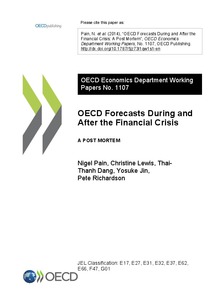OECD forecasts during and after the financial crisis. A post mortem
"This paper assesses the OECD’s projections for GDP growth and inflation during the global financial crisis and recovery, focussing on lessons that can be learned. The projections repeatedly over-estimated growth, failing to anticipate the extent of the slowdown and later the weak pace of the r...
| Main Authors: | , , , , |
|---|---|
| Institution: | ETUI-European Trade Union Institute |
| Format: | TEXT |
| Language: | English |
| Published: |
Paris
2014
OECD |
| Subjects: | |
| Online Access: | https://www.labourline.org/KENTIKA-19110286124919384689-oeCD-forecasts-during-and-afte.htm |
| Summary: | "This paper assesses the OECD’s projections for GDP growth and inflation during the global financial crisis and recovery, focussing on lessons that can be learned. The projections repeatedly over-estimated growth, failing to anticipate the extent of the slowdown and later the weak pace of the recovery – errors made by many other forecasters. At the same time, inflation was stronger than expected on average. Analysis of the growth errors shows that the OECD projections in the crisis years were larger in countries with more international trade openness and greater presence of foreign banks. In the recovery, there is little evidence that an underestimate of the impact of fiscal consolidation contributed significantly to forecast errors. Instead, the repeated conditioning assumption that the euro area crisis would stabilise or ease played an important role, with growth weaker than projected in European countries where bond spreads were higher than had been assumed. But placing these errors in a historical context illustrates that the errors were not without precedent: similar-sized errors were made in the first oil price shock of the 1970s. In response to the challenges encountered in forecasting in recent years and the lessons learnt, the OECD and other international organisations have sought to improve their forecasting techniques and procedures, to improve their ability to monitor near-term developments and to better account for international linkages and financial market developments." |
|---|---|
| Physical Description: | 91 p. Digital |

